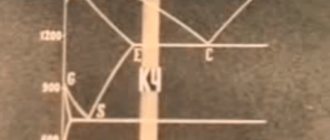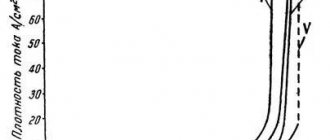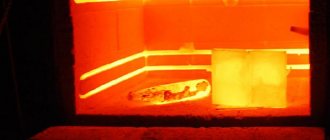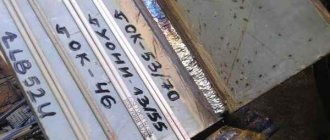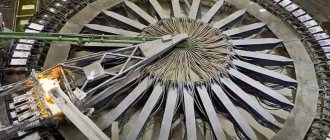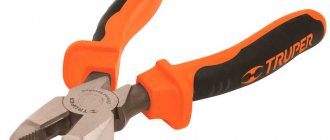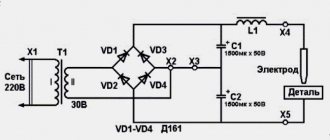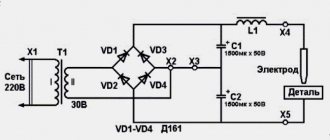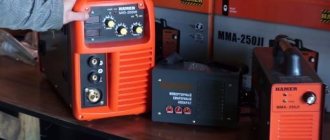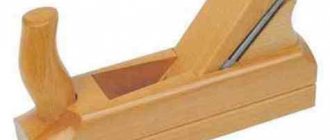Differences
In metallurgy, a fairly large number of varieties of steel are distinguished. Their classification depends on the amount of one or another component in the mixture. For example, a high content of binding elements produces high-alloy (more than 11%) steel. In addition there are:
- low alloyed – up to 4% binding components;
- medium alloyed - up to 11% of connecting elements.
The carbon content in the alloy also gives its classification to the metal:
- low-carbon metal – up to 0.25% C;
- medium carbon metal – up to 0.55% C;
- high carbon – up to 2% C.
And finally, depending on the content of non-metallic inclusions that are formed as a result of reactions (for example, oxides, phosphides, sulfides), classification is carried out according to physical properties:
- especially high quality;
- high quality;
- quality;
- ordinary steel.
This is far from a complete classification of steel. The types are also distinguished by the structure of the material, production method, and so on. But no matter how the main components are fused, the result is a hard, durable, wear-resistant and deformation-resistant material with a specific gravity of 7.75 (up to 7.9) G/cm3. The melting point of steel is from 1450 to 1520°C.
Unlike steel, cast iron is more fragile; it is distinguished by its ability to collapse without noticeable residual deformations. In this case, the carbon itself in the alloy is presented in the form of graphite and/or cementite; their shape and, accordingly, quantity determine the types of cast iron:
- white - all the necessary carbon is contained in the form of cementite. The material is white when broken. Very hard, but fragile. It can be processed and is mainly used to produce the malleable variety;
- gray – carbon in the form of graphite (plastic form). It is soft, easily processed (can be cut) and has a low melting point;
- malleable - obtained after prolonged annealing of a white appearance, resulting in the formation of graphite. Heating (over 900°C) and the cooling rate of graphite negatively affect the properties of the material. This makes welding and processing difficult;
- high-strength - contains spherical graphite formed as a result of crystallization.
The carbon content in the composition determines its melting point (the more it is, the lower the temperature) and the higher the fluidity when heated. Therefore, cast iron is a fluid, non-plastic, brittle and difficult to process material with a specific gravity of 6.9 (7.3) G/cm3. Melting point – from 1150 to 1250°C.
Production volumes
Cast iron cast into ingots
Play media
Release of pig iron from a blast furnace
In 1892, Germany produced 4.9 million tons of pig iron, against 6.8 in England, and in 1912 it was already 17.6 against 9.0[29]
World production of pig iron in 2009 amounted to 898.261 million tons, which is 3.2% lower than in 2008 (927.123 million tons)[30]. The top ten pig iron producing countries looked like this:
| Place in 2009 | A country | Pig iron production, million tons |
| 1 | China | 543,748 |
| 2 | Japan | 66,943 |
| 3 | Russia | 43,945 |
| 4 | India | 29,646 |
| 5 | South Korea | 27,278 |
| 6 | Ukraine | 25,676 |
| 7 | Brazil | 25,267 |
| 8 | Germany | 20,154 |
| 9 | USA | 18,936 |
| 10 | France | 8,105 |
For four months of 2010, global production of pig iron amounted to 346.15 million tons. This result is 28.51% more compared to the same period in 2009.[31]
Conclusions TheDifference.ru
- Steel is stronger and harder than cast iron.
- Cast iron is lighter than steel and has a lower melting point.
- Due to its lower carbon content, steel is easier to process (welding, cutting, rolling, forging) than cast iron.
- For the same reason, cast iron products are made only by casting.
- Products made of cast iron are more porous (due to casting) than those made of steel, and therefore their thermal conductivity is much lower.
- Typically, art products made from cast iron are black and matte, while those made from steel are light and shiny.
- Cast iron has low thermal conductivity, while steel has higher thermal conductivity.
- Cast iron is the primary product of ferrous metallurgy, and steel is the final product.
- Cast iron is not hardened, but some types of steel must be subjected to a hardening procedure.
- Products made of cast iron are only cast, and products made of steel are forged and welded.
Story
See also: History of the production and use of iron and Blast Furnace § History
At the beginning of the 1st millennium BC. e. The technology of smelting cast iron in crucibles was mastered in China and the adjacent Far Eastern territories. The charge consisted of cast iron and charcoal; smelting was carried out over several days at temperatures above 1200 °C. Later, Chinese metallurgists invented a special furnace for smelting pig iron from iron ore or cast iron, called the “Chinese” cupola furnace. The oven was essentially a cheese furnace about 1 m high, equipped with a blower box that provided air flow into the oven. In the V-III centuries BC. e. In China, the production of complex iron castings was mastered. This period is considered to be the beginning of artistic iron casting[3][4].
At the beginning of the 1st century[5], cast iron coins appeared in China, but bronze coins remained in widespread use until the 19th century[6]. In the 11th century, the cast iron spire of the Lingxiao Pagoda was erected. The finds of cast iron cauldrons of the Golden Horde (Tula region) date back to the 14th century[7], but on the territory of Mongolia (Karakorum) the Mongols knew how to make cast iron cauldrons back in the 13th century[8]. In 1403, a cast iron bell was cast in China (Beijing)[9].
The appearance of cast iron in Europe dates back to the 14th century, when the first smelting began in stückofen to produce liquid cast iron. In Russia, the first cast iron was smelted in the 16th century[10][11]. The first domnitsa were built most actively in the 2nd half of the 15th century in Italy, the Netherlands and Belgium. German metallurgists continued to smelt metal in blauofen for a long time[1].
In the 14th-15th centuries in Europe, from the 16th century in Russia, the first solid cast iron cannons and cannonballs appeared [12][13][14]. The discoverer of this technology is considered to be foundry master Peter Bode from the village of Buxted[en], who worked in the foundry of Henry VIII[15].
In 1701, the Kamensky iron foundry in the Urals (Russia) produced the first batch of cast iron (262 kg). In the Urals, iron casting has become a folk craft. In the 18th century, the first cast iron bridge appeared in England. In Russia, a cast iron bridge appeared only at the beginning of the 19th century. This was made possible thanks to Wilkinson's technology. In the same century, rails began to be made from cast iron[16]. In addition to industrial use, cast iron continued to be used in everyday life. In the 18th century, cast iron pots appeared and were widely used in Russian stoves[17].
At the beginning of the 18th century in Western Europe, the problem of depletion of forests used to produce charcoal became acute. The search began for alternative fuels for blast furnaces. The first experiments in the use of prepared coal and peat in blast furnace smelting were carried out in England and Germany back in the first half of the 17th century. At the beginning of the 18th century, the technology of coking coal was mastered in England. In 1735, pig iron was first smelted in England using only coal coke. Subsequently, coke metallurgy spread throughout the world[11][18]. By 1850, 70% of all blast furnaces in the world were powered by coke, and by 1900 - 95%[19][20].
By the end of the 18th century, Russia took first place in the production of cast iron and produced 9,908 thousand pounds of cast iron, while England - 9,516 thousand pounds, followed by France, Sweden, and the USA[21].
At the beginning of the 19th century, the production of malleable cast iron was mastered. In the 2nd quarter of the 20th century, alloying of cast iron began to be used[10].
In 1806, Great Britain smelted 250 thousand tons of cast iron, ranking first in the world in its production, and by the middle of the 19th century, half of the world's cast iron production was concentrated in Great Britain. However, in 1890, the United States took first place in the production of cast iron[22]. The technology of the Bessmer process (1856) and the open-hearth furnace (1864) made it possible for the first time to produce steel from cast iron. In the 19th century, cast iron was widely used for the manufacture of Victorian fireplaces[23], as well as decorative elements (for example, the cast iron grate of the monument to Alexander II, 1890). Thanks to the production of small sculptures and openwork items made of cast iron, the Kusinsky and Kasli factories became widely known.
The development of molding methods for casting complex artistic castings at a plant in the village of Kasli led to the creation of a method for producing core molds, which is still used today, especially in machine tool building[24]. Also in the 19th century, London's 12-inch water and sewer pipes were made from cast iron[25].
Heat and sparkle
How to distinguish cast iron from steel? You need to operate with the necessary equipment and a little patience.
In the first case, you can resort to heating, for example, using a blowtorch, initially wearing special protective clothing and following safety rules at work. The temperature must be increased before the metal begins to melt. It has already been said that the melting point of cast iron is higher than that of steel. However, this applies mainly to white and pig iron. Regarding all industrial grades, they contain carbon in an amount of no more than 4.3% and melt at 1000-1200˚C. Thus, it can be melted much faster.
An educational method for obtaining information about how cast iron differs from steel is to use an experimental sample on a grinding machine or under a sharp wheel of a grinding machine. The analysis is carried out according to the characteristics of the sparks. Cast iron is characterized by dim red sparks, while steel is characterized by bright, blinding short rays with a white-yellow tint.
Factors affecting the processing of steel and cast iron
In order not to waste money and resources, it is very important to know how to identify cast iron or steel.
- Selecting a welding electrode
- drill sharpening angle
- drilling and milling mode
These are not all the factors that can complicate the life and work of a person who incorrectly determines the type of metal. Reducing mechanical, strength and violating guaranteed repair intervals is a much greater evil that can damage production and the budget in the event of an error.
Color features and fragility analysis
In order to know how to distinguish cast iron from steel by eye, you need to remember the main visual differences. Cast iron is characterized by a matte gray color and a rougher external texture. Steel is characterized by its special silvery shiny hue and minimal roughness.
Also important knowledge on how to distinguish cast iron from steel visually is information about the ductility of these materials. If the workpieces or metal objects being examined do not have serious value, you can test them for strength and ductility by applying impact force. Brittle cast iron will crumble into pieces, while steel will only deform. With more serious crushing loads, cast iron crumbs will turn out to be of small, varied shapes, and pieces of steel will be large, with the correct configuration.
What does it sound like
An interesting feature is how to distinguish cast iron from steel by sound. The two alloys sound different. It is not at all necessary to produce musical accompaniment using existing experimental facilities. But it is necessary to have both samples or have an experienced ear in this matter. Steel is characterized by a higher density, which is reflected in its sound. When you hit it with a metal object, the sound is much louder than in the same situation with cast iron.
In order to know how cast iron differs from steel, you need to have a little knowledge about these materials and some experience. After all, an experienced professional in the field of forging, grinding, milling, drilling, turning, heat treatment or welding, a metallurgist or technician can easily distinguish them from each other, assessing them only visually or by touch.
What is cast iron?
Cast iron is an alloy of ferum and carbon, but the proportion of the latter must be above 2%. Otherwise, it will already be steel. Casting of materials was first started in China in the 10th century. Further, cast iron was evenly distributed throughout all developed corners of the planet, and became one of the most common metal alloys on earth.
Welding cast iron at home
The top 5 countries in terms of pig iron production include China, Japan, Russia, India and Korea. The high demand for the material is not only due to its domestic use. Cast iron is often used as a basis for the manufacture of steel alloys, which means that an extremely large volume of material is required.
| Advantages of cast iron | Disadvantages of the alloy |
| Some grades of cast iron have strength levels similar to steel. | With prolonged exposure to water, corrosion processes will begin on the surface of cast iron. |
| Uniform heat distribution + long-term storage. | |
| Eco-material, and therefore safe in the production of tableware. | The cost of cast iron is higher than classic steel. |
| It is resistant to acid-base environments. | |
| High level of hygiene. | Gray cast iron is not ductile, and white cast iron is too brittle. |
| Durability due to high corrosion resistance. |
Steel
An iron-carbon alloy containing carbon in an amount of not more than 2.14% and iron - not less than 45% is called steel. Its main characteristics:
- Smooth, has a silvery color with a characteristic reflection.
- Melting within 1450˚С.
- Density ranges from 7700 to 7900 kg/m3.
- Heat capacity at room temperature: 462 J/(kg˚C).
- Low hardness, on average 120-250 HB.
- Excellent ductility: the relative elongation coefficient δ for different brands ranges from 5-35%, for most – δ≥20-40%.
- Average values of tensile strength for structural materials are 300-450 MPa; for especially strong alloyed ones – 600-800 MPa.
- It lends itself well to correction of properties using thermal and chemical-thermal treatment.
- It is actively doped with various chemical elements in order to change its properties and purpose.
- Qualitatively high indicators of weldability, machinability and cutting.
- Characterized by low corrosion resistance.
Steel is the main structural alloy in modern metallurgy, mechanical engineering, instrument making and technology.
Determining origin by type of part
Having examined the detailed characteristics of these alloys, you can confidently use the knowledge of how cast iron differs from steel. Having a metal object in front of you, doubting its origin, it is rational to immediately remember the main distinctive technological properties. So, cast iron is a casting material. It is used to produce simple dishes, massive pipes, housings of machine tools, engines, and large objects of simple configuration. Parts of all sizes and complexity are made from steel, as forging, stamping, drawing, rolling and other methods of metal forming are used for this purpose. Thus, if there is a question about the origin of the reinforcement, there can be no doubt - it is steel. If you are interested in the origin of a massive cauldron, it is cast iron. If you need to find out what the engine housing or crankshaft is made of, you should resort to other recognition options, since both options are possible.
